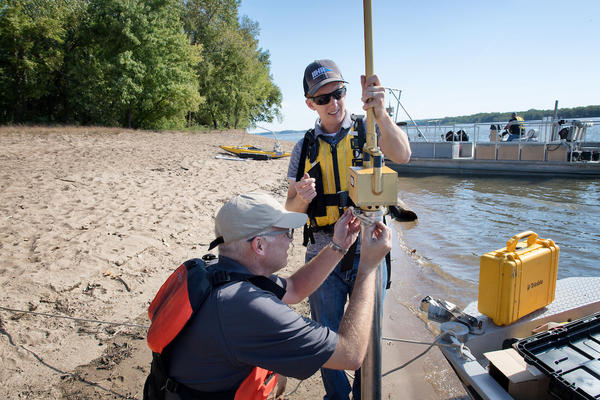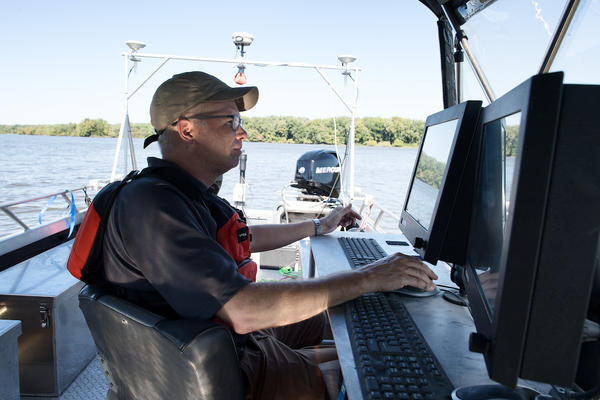World-renowned water expert charts own path at Iowa

V.C. Patel studied and taught hydrodynamics at the University of Iowa for nearly four decades, racking up prestigious awards and appointments and writing four books and more than 200 academic papers along the way. But when he started his career, he was headed in a different direction.
“I’m a fluid dynamicist by training, and I got my degrees in aerodynamics,” says Patel, who was born in Kenya and received a PhD in aeronautics from the University of Cambridge. “My first job was as a consultant at Lockheed Martin in Georgia. I created computer programs to design airplane wings.”
However, a chance encounter with Lou Landweber, a professor of mechanics and hydraulics who helped make Iowa an international leader in ship hydrodynamics, changed Patel’s career path. Landweber brought Patel to the UI campus in 1970 to give a guest lecture and then convinced him to stay. Landweber became Patel’s mentor and encouraged him to switch his focus from the movement of air to the movement of water. It’s a decision Patel doesn’t regret.
“The reason I stayed at Iowa and the reason I flourished here is because of the support of people like Lou, people for whom I had immense respect and to whom I felt incredibly loyal,” says Patel, who retired in 2007, not long after serving as the seventh director of IIHR—Hydroscience & Engineering, one of the UI’s oldest and most active research institutes, from 1994 to 2004.
“I think that Iowa still stands as a bright beacon for people wanting to do academic research and applied research in the field of hydroscience. The administration is very supportive of creative research, of vibrant research. If you are ready, you can really chart your own path.”
Research opportunities, including those with collaborators from across campus and diverse fields of study, also inspired and engaged him. Besides working with Landweber in IIHR’s towing tank, a lab designed to allow researchers to study ship propulsion and maneuvering, Patel was one of the first researchers to conduct experiments using computers, which, when he arrived at Iowa in 1971, were just starting to be used in academic research.
“I still remember going into the computer room with my box of punch cards,” Patel says.
As computer speed and power improved, Patel expanded his techniques. In the 1980s, he became one of the first researchers in the nation to perform computational fluid dynamics, including application of full-blown Navier-Stokes equations—equations used to describe the motion of viscous fluid substances, as well as turbulence modeling and flows around ships.
Patel’s efforts in this area brought him international notoriety, and in 1981 he was invited to attended the International Towing Tank Conference in St. Petersburg, then known as Leningrad, a part of the former Soviet Union. At this conference, Patel met U.S. Navy personnel who asked him how they could duplicate certain capabilities of Soviet submarines. Patel devised a comprehensive research program to model the flow of water around a vessel, from bow to wake. As a result, the Office of Naval Research extended a long-term, special focus grant to the UI. The grant marked the beginning of a research partnership between the U.S. Navy and the UI that remains strong today.
“What I found was that the same tool box of skills I had developed in aeronautics could also be applied to ships, because you have the math and the physics. And you just go with it—you just take it and apply it to other problems,” Patel says. “So, at Iowa, we pushed ship hydrodynamics higher and higher to the point where we brought in computational fluid dynamics, and at that time, we were the pioneers. People looked to Iowa, and we had a big impact. We still do.”
Besides his work in ship hydrodynamics, Patel used his expertise in turbulent flow to produce numerical simulations of three-dimensional flows through systems as varied as the human voice box and hydropower installations, including dams and reservoirs. His passion for computer-aided research and his insistence—especially during his tenure as director of IIHR—that it be made widely available, is credited with bolstering and modernizing research techniques at Iowa.
“V.C. ushered IIHR into the 21st century,” says Larry Weber, who succeeded Patel as IIHR director and served in that role from 2004 to 2017. “He also oversaw the creation of a new hydroscience research station on the Mississippi River and initiated a study-abroad class, International Perspectives in Water Resources Planning. His changes as director laid the groundwork for the broad-based, diverse research that now characterizes IIHR.”
During his tenure as IIHR director, Patel worked to diversify hydroscience staff, adding important expertise in hydrometeorology, an area of study that has since spun off to form a new research hub focused on flood research and education. Created in 2009, the Iowa Flood Center at the University of Iowa produces research in hydrologic modeling, flood forecasting, and remote sensors. The Flood Center also helps lead a $96.9 million federal grant program called the Iowa Watershed Approach, which aims to reduce flooding through improved storm water management and flood resilience practices.
Looking back on his career in hydrodynamics at Iowa, Patel says he is proud of the contributions he and his colleagues made to the field of fluids movement. Looking forward, he says he’s confident Iowa will retain its place as an international leader in the field.
“I think that Iowa still stands as a bright beacon for people wanting to do academic research and applied research in the field of hydroscience,” he says. “The administration is very supportive of creative research, of vibrant research. If you are ready, you can really chart your own path.”
Learn more about hydroscience at the University of Iowa.

















